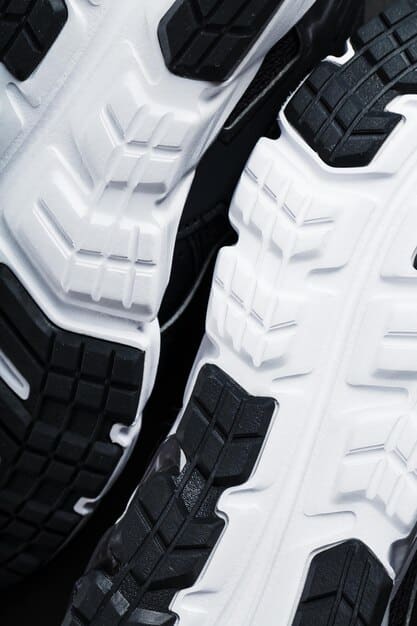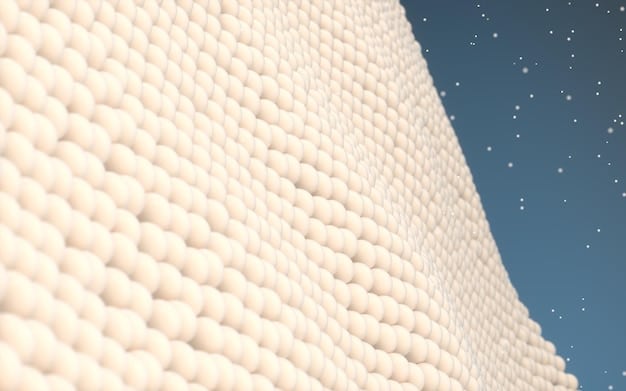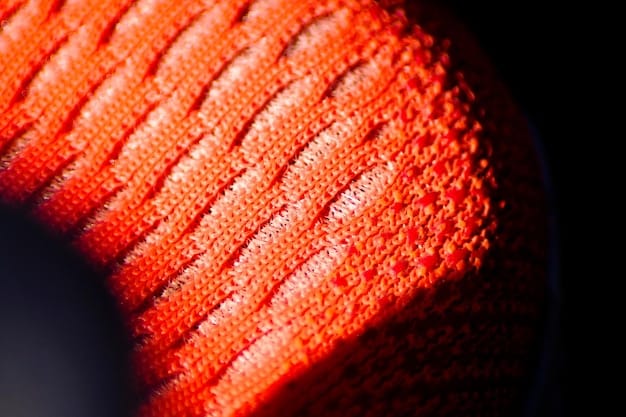Shoe Cushioning Science: EVA, TPU, and Boost Tech Explained

Advertisements
The science of shoe cushioning involves understanding materials like EVA, TPU, and Boost, each offering unique properties that affect comfort, performance, and impact absorption in athletic footwear.
Dive into the world of footwear and discover the science behind shoe cushioning: understanding EVA, TPU, and Boost technologies, and how they impact your comfort and performance.
Advertisements
Understanding Shoe Cushioning: An Introduction
When choosing athletic or everyday footwear, cushioning is a key consideration. It’s what makes the difference between a comfortable stride and a jarring impact with every step. Different materials and technologies offer varying degrees of shock absorption, stability, and responsiveness. This exploration will dissect the science behind some of the most popular cushioning technologies found in shoes today.
Exploring the materials commonly used in shoe cushioning provides a foundation for evaluating your needs and preferences. Let’s start with EVA, a ubiquitous material known for its versatility and affordability.
Advertisements
EVA: The Budget-Friendly Foundation
Ethylene-vinyl acetate, better known as EVA, is a staple in the shoe industry. Its versatility and cost-effectiveness make it a popular choice for a wide range of footwear, from budget-friendly sneakers to high-performance athletic shoes. Understanding the properties of EVA can help you appreciate its role in providing basic cushioning and comfort.
EVA foam is created by blending ethylene and vinyl acetate, then expanding the mixture to create a cellular structure filled with air pockets. This process results in a lightweight and flexible material that can absorb impact. The density of EVA can be adjusted to provide different levels of cushioning, making it suitable for various activities.

Benefits of EVA
- Lightweight: EVA’s low density keeps shoes light, reducing fatigue during extended wear.
- Affordable: Making it accessible for budget-conscious consumers.
- Versatile: Suitable for various shoe types and activity levels.
Limitations of EVA
- Degradation: EVA can compress and lose its cushioning over time, especially with heavy use.
- Temperature Sensitivity: Its performance can be affected by extreme temperatures.
- Less Responsive: It provides cushioning but may not offer the same energy return as other advanced materials.
In summary, EVA offers a good balance of cushioning, weight, and cost, making it a practical choice for many types of shoes. However, for those seeking more advanced performance features, other materials like TPU and Boost offer enhanced benefits.
TPU: The Durable Performer
Thermoplastic polyurethane, or TPU, is a step up in durability and performance. This material is engineered to withstand more wear and tear while providing superior cushioning and responsiveness.
TPU is a type of plastic that is both elastic and resistant to abrasion and impact. Unlike EVA, TPU maintains its shape and cushioning properties for a longer period, making it ideal for high-performance athletic shoes. It is often used in midsoles, outsoles, and even as a reinforcing component in other parts of the shoe.
TPU Advantages
- Durability: TPU stands up to wear more effectively than EVA.
- Responsiveness: Offers better energy return, enhancing athletic performance.
- Versatility: Often combined with other materials to optimize cushioning and support.
Potential Drawbacks
- Cost: Generally more expensive than EVA.
- Weight: Can be heavier than EVA, depending on the formulation and application.
- Stiffness: Some TPU formulations may feel firmer compared to softer cushioning options.
TPU’s enhanced durability, responsiveness, and versatile application make it a popular choice for athletic shoes. Now, let’s move on to Adidas’ Boost technology, known for its unique design and performance characteristics.
Boost: The Energy-Returning Innovator
Boost technology, developed by Adidas in collaboration with BASF, revolutionized shoe cushioning with its unique expanded thermoplastic polyurethane (eTPU) design. This innovative approach provides exceptional energy return and comfort.
Boost consists of thousands of tiny, closed-cell capsules made from TPU. These capsules are fused together to form a midsole that is highly resilient and responsive. When compressed, the capsules store energy and then release it upon impact, providing a spring-like effect that enhances running efficiency and reduces fatigue.

Key Benefits of Boost
- Energy Return: Boost’s standout feature is its ability to return a substantial amount of energy with each step.
- Comfort: Provides a plush and comfortable ride.
- Temperature Resistance: Maintains its performance in a wide range of temperatures.
Considerations
- Cost: Shoes with Boost technology tend to be premium-priced.
- Aesthetics: The visible capsule design may not appeal to everyone.
- Weight: While lightweight, it can be slightly heavier than some EVA foams.
In summary, Adidas’ Boost technology represents a significant advancement in shoe cushioning, offering a unique combination of energy return, comfort, and temperature resistance.
Comparing EVA, TPU, and Boost
Choosing the right cushioning technology depends on individual needs and preferences. EVA, TPU, and Boost each offer unique characteristics that cater to different priorities. This section will provide a comparative analysis to help you make an informed decision.
EVA is an excellent choice for everyday use and budget-conscious consumers seeking basic cushioning. TPU offers enhanced durability and responsiveness, making it suitable for athletes and those who demand more from their footwear. Boost, is an innovative solution that delivers exceptional energy return and comfort at a premium price.
Key Differences
Consider the level of performance and comfort you need, along with your budget, when selecting your next pair of shoes.
- Cushioning: EVA provides basic cushioning, TPU offers enhanced support and impact absorption, and Boost delivers superior energy return.
- Durability: EVA is the least durable, while TPU and Boost are more resistant to wear and tear.
- Cost: EVA is the most affordable, followed by TPU, with Boost being the most expensive.
Making the Right Choice
- Everyday Use: If you need comfortable shoes for walking or casual activities, EVA may suffice.
- Athletic Performance: For running, training, or sports, TPU or Boost can enhance your performance and reduce fatigue.
- Budget: if you are limited the EVA it’s the best option but if youre willing to invest, Boost could allow you to feel more energy efficient.
Ultimately, the best cushioning technology depends on individual needs and priorities, so explore the options and choose what feels right for you.
The Role of Cushioning in Different Activities
Different sports and activities place varying demands on footwear. Understanding these demands can help you choose shoes with the appropriate cushioning technology for optimal performance and protection.
Running shoes, for example, require cushioning that can absorb the impact of repetitive strides while providing energy return to propel you forward. Basketball shoes need cushioning that can handle the high-impact forces of jumping and landing, while also providing stability for quick cuts and changes in direction. Each activity has nuances and factors you need to consider.
Cushioning for Runners
Different running styles and distances call for different cushioning properties. Lightweight runners may prefer firmer cushioning, while heavier runners may benefit from softer, more forgiving materials. Consider the distances and types of terrain you usually run on.
- Road Running: Look for shoes with ample cushioning to absorb impact on hard surfaces.
- Trail Running: Choose shoes with rugged outsoles and responsive cushioning for stability and protection on uneven terrain.
- Long Distance: Prioritize cushioning and energy return to minimize fatigue over extended periods.
Cushioning for Other Activities
- Walking: Comfortable, lightweight cushioning is key for everyday wear.
- Training: Versatile cushioning that can handle a variety of exercises.
- Sports: Sport-specific cushioning that protects against high-impact forces and provides stability.
By considering the specific demands of your activities, you can choose footwear that provides the right balance of cushioning, support, and performance, enhancing comfort and reducing of injuries.
The Future of Shoe Cushioning
The science of shoe cushioning continues to evolve, with researchers and manufacturers constantly exploring new materials and technologies to enhance performance, comfort, and durability. Innovations such as 3D-printed midsoles and customized cushioning systems are paving the way for more personalized and effective footwear. A look to the future can give us a bigger glimpse into whats next.
As technology advances, we can expect to see even more sophisticated cushioning solutions that adapt to individual needs and activities. For example, some researchers are developing smart materials that can adjust their properties in response to changes in pressure or temperature, providing customized support and cushioning on demand.
Emerging Trends
- 3D-Printed Midsoles: Allowing for customized cushioning based on individual foot scans and biomechanics.
- Smart Materials: Adapting to changes in pressure and temperature for personalized support.
- Sustainable Materials: Eco-conscious alternatives that reduce environmental impact without compromising performance.
The Path Ahead
These advancements promise to revolutionize the way we experience footwear, providing better protection, comfort, and performance for athletes and everyday consumers alike. Staying informed about these developments can help you choose the best shoes for your needs and enjoy the future of shoe cushioning.
In conclusion, the quest for optimal shoe cushioning is an ongoing journey. As technologies evolve and new materials emerge, the future of footwear looks promising.
| Key Point | Brief Description |
|---|---|
| 💡 EVA Foam | Budget-friendly, lightweight cushioning suitable for everyday use but less durable. |
| 💪 TPU Material | Durable and responsive cushioning for athletic performance, offering better energy return. |
| 🚀 Boost Technology | Innovative eTPU design, providing exceptional energy return and comfort for running. |
| 👟 Activity Needs | Choose cushioning based on the demands of your activities (running, walking, sports) for optimal performance. |
FAQ Section
▼
EVA (Ethylene-vinyl acetate) foam is a lightweight, flexible material commonly used in shoes for basic cushioning. Its affordability and versatility make it ideal for various shoe types.
▼
TPU (Thermoplastic polyurethane) is more durable and responsive than EVA, providing better energy return and resistance to wear. It’s suitable for athletic shoes needing enhanced performance.
▼
Boost offers exceptional energy return, comfort, and temperature resistance. The unique eTPU capsule design enhances running efficiency and reduces fatigue.
▼
TPU and Boost are excellent for running. TPU provides durability and responsiveness, while Boost excels in energy return and comfort, optimizing running performance.
▼
Consider the activity, your budget, and your preferences for cushioning. EVA is good for everyday use, TPU for durability, and Boost for premium energy return.
Conclusion
Understanding the science of shoe cushioning: understanding EVA, TPU, and Boost technologies can significantly enhance your footwear choices. Each material offers distinct benefits, catering to various activities and performance needs. Whether you prioritize affordability, durability, or energy return, there is a cushioning technology that is perfect for you. As the science continues to evolve, staying informed will ensure you make the best decisions for your comfort and well-being.